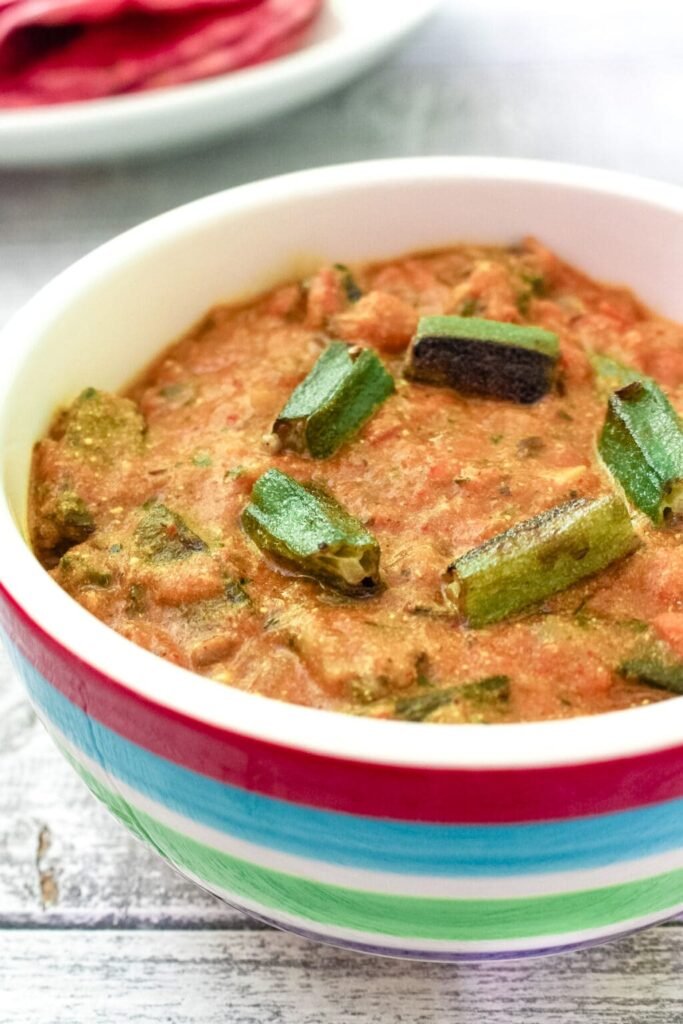If you’re someone who usually skips okra because of its slimy texture, this dish will completely change your mind. Dahi Bhindi — also known as Bhindi in Yogurt Gravy — is a simple yet irresistible North Indian-style curry that’s tangy, mildly spiced, and full of comforting flavors. What makes it stand out is its rich, creamy yogurt base paired with perfectly sautéed okra that stays crisp and non-slimy.
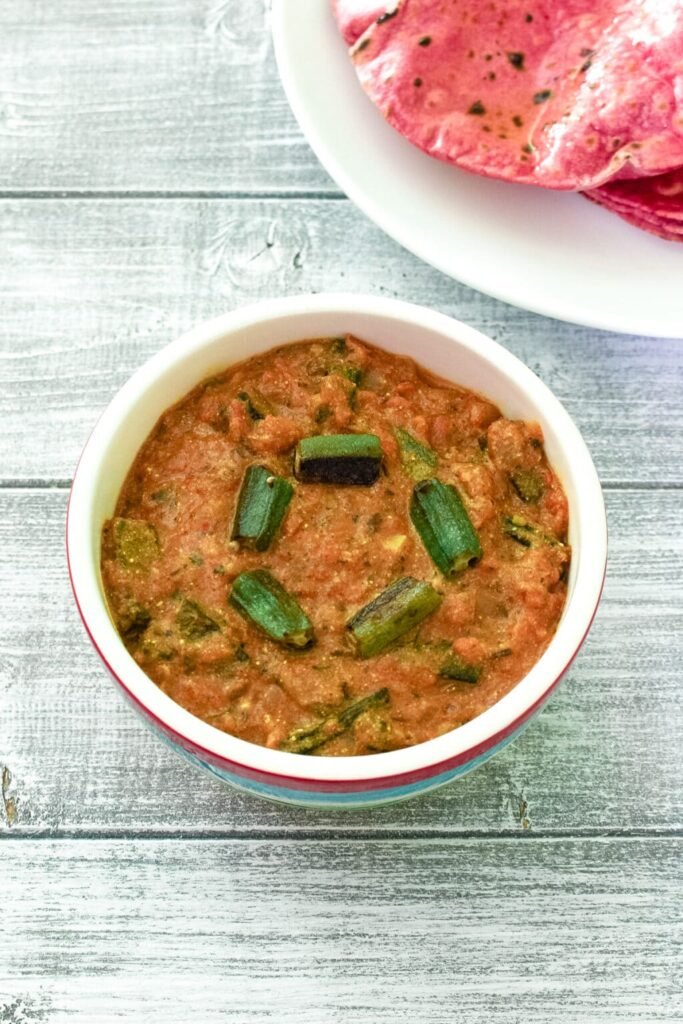
In this recipe, fresh bhindi (okra) is stir-fried until tender and lightly crisp, then added to a velvety yogurt gravy infused with warm spices like cumin, coriander, and garam masala. The natural tang of yogurt pairs wonderfully with the subtle, earthy flavor of okra, resulting in a well-balanced and flavorful dish with a delightful contrast in taste and texture.
This flavorful curry goes perfectly with soft rotis, flaky parathas, or even a simple bowl of jeera rice. It’s easy and quick to prepare, making it ideal for busy weeknights, yet elegant enough to serve on special occasions. What makes it even more versatile is that it’s made without onion or garlic, making it a great choice for festive cooking or those following a sattvic diet.
Whether you’re cooking for your family or looking to impress someone with a traditional Indian vegetarian curry, give this Dahi Bhindi a try. It’s the kind of dish that might surprise you — and very likely earn a permanent spot in your regular meal rotation!
You’ll Love This Dahi Bhindi Recipe
- Everyday Comfort Sabzi: Dahi Bhindi is one of those comforting dishes you’ll want to keep in your regular meal rotation. Made with everyday pantry staples, it’s not only wholesome and flavorful but also light on the stomach. It’s an ideal option for days when you want a meal that’s both light and fulfilling without much effort. The use of yogurt makes the curry creamy and mildly tangy, without being too heavy — perfect for everyday lunch or dinner.
- Perfect for Tiffin & Lunchboxes: Looking for a dry-style sabzi with gravy that travels well? Great for lunchboxes—perfect for both kids and adults. Just make sure to pack it in a leak-proof container and pair it with soft rotis or parathas packed separately. It stays fresh for hours and doesn’t become overly soggy or sticky, which makes it a reliable option for meals on the go.
- Foolproof & Beginner-Friendly: This dahi bhindi recipe is beginner-friendly and fuss-free, with simple steps and no fancy ingredients needed. Just follow the basic process — sauté the bhindi, prepare the spiced yogurt base, and mix. With minimal effort, you get maximum flavor!
- Flavor Profile: This dish has a gentle heat from the spices, a subtle tanginess from tomatoes, and a rich sour note from the yogurt. The combination of flavors is well-balanced — not too spicy, not too bland — making it a crowd-pleaser for all age groups.
- Yogurt Tip: When incorporating yogurt into a hot gravy, be sure to lower the flame and whisk the yogurt well beforehand. Sudden heat can cause it to split or curdle. Follow the tips in the recipe to keep the texture smooth and creamy.
Ingredient Notes:
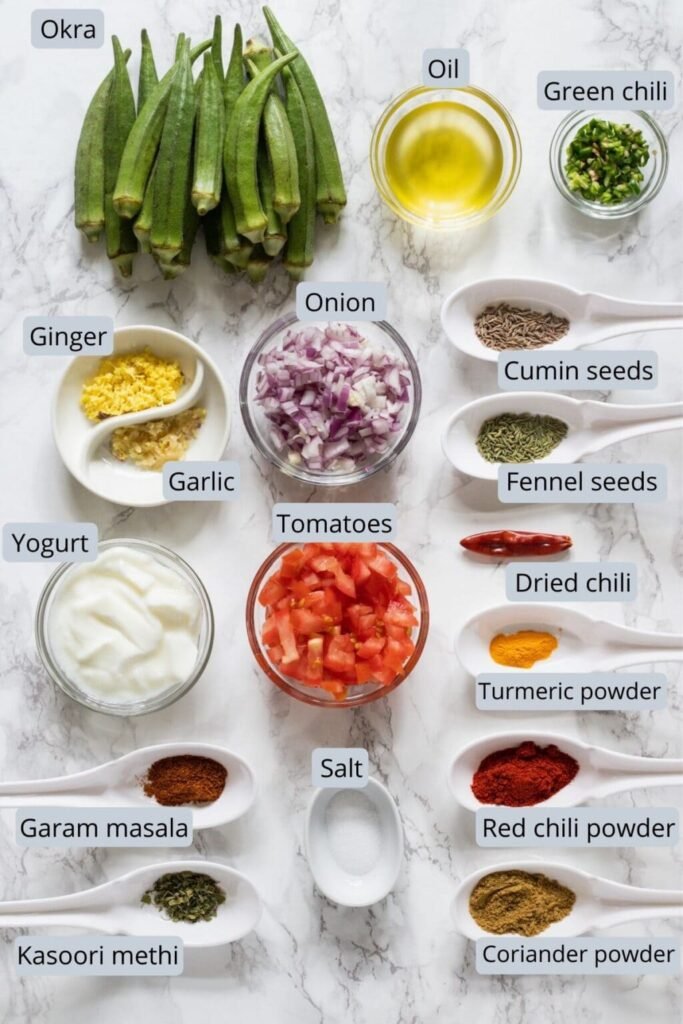
- Okra (Bhindi): Both fresh and frozen okra work well in this recipe. If using fresh bhindi, rinse it well and let it drain fully in a colander to remove excess moisture. Letting it air dry is best — I usually wash it earlier in the day and let it dry naturally on the counter. However, if you’re short on time, use a clean kitchen towel or paper napkins to gently pat each piece dry. This step is crucial because excess moisture leads to stickiness when cooking okra.
- When shopping, I personally prefer the thin, tender desi okra available at Indian grocery stores. These have fewer seeds and cook faster. The larger, thicker variety often sold in Western supermarkets tends to have big, tough seeds, which can affect both texture and taste.
- Fennel Seeds (Saunf): A small touch of fennel seeds in this dish adds a subtle sweet and aromatic note that perfectly complements the tang of the yogurt. It brings a refreshing contrast to the other warm spices, enhancing the overall flavor.
- Kasoori Methi (Dried Fenugreek Leaves): Crush the kasoori methi between your palms before adding it to the gravy. This simple step helps release its deep, earthy aroma and flavor, elevating the taste of the final dish.
- Yogurt (Dahi): Use only fresh and mildly sweet yogurt for this recipe. Avoid overly sour or old yogurt, as it can make the gravy unpleasantly tangy. Fresh curd not only balances the spices well but also gives the curry a smooth, rich texture without overpowering tartness.
How To Make Dahi Bhindi?
1) Start by warming 2 tablespoons of oil in a broad pan over medium heat. Once the oil is hot, add the chopped okra and sprinkle a little salt to season it. Stir to coat the pieces evenly in oil.
2) Allow the bhindi to cook uncovered. Stir occasionally for even cooking. As it cooks, the okra will shrink in size and develop a darker color with slightly crisp edges. Once it becomes tender and no longer sticky, remove it from the pan and set it aside on a plate.

3) Pour the remaining 1 tablespoon of oil into the same pan, allowing it to heat up before adding the next ingredients. When it heats up, add cumin seeds, fennel seeds, and a dry red chili (optional but recommended for flavor). Let the seeds sizzle and become aromatic — this adds a strong base flavor to the dish.
4) Next, add the finely chopped onions to the pan, followed by ginger paste, garlic paste, and finely chopped green chili. Stir everything together to combine the flavors. Mix everything well and sauté the mixture.
5) Continue cooking until the onions turn light golden brown and the raw smell of ginger and garlic disappears completely. This is important for a well-rounded flavor.
6) Add the chopped tomatoes and mix them well into the masala base.
7) Cook until the tomatoes break down completely and become soft and pulpy. As they soften, use the back of your spoon to gently mash them to form a smoother base.
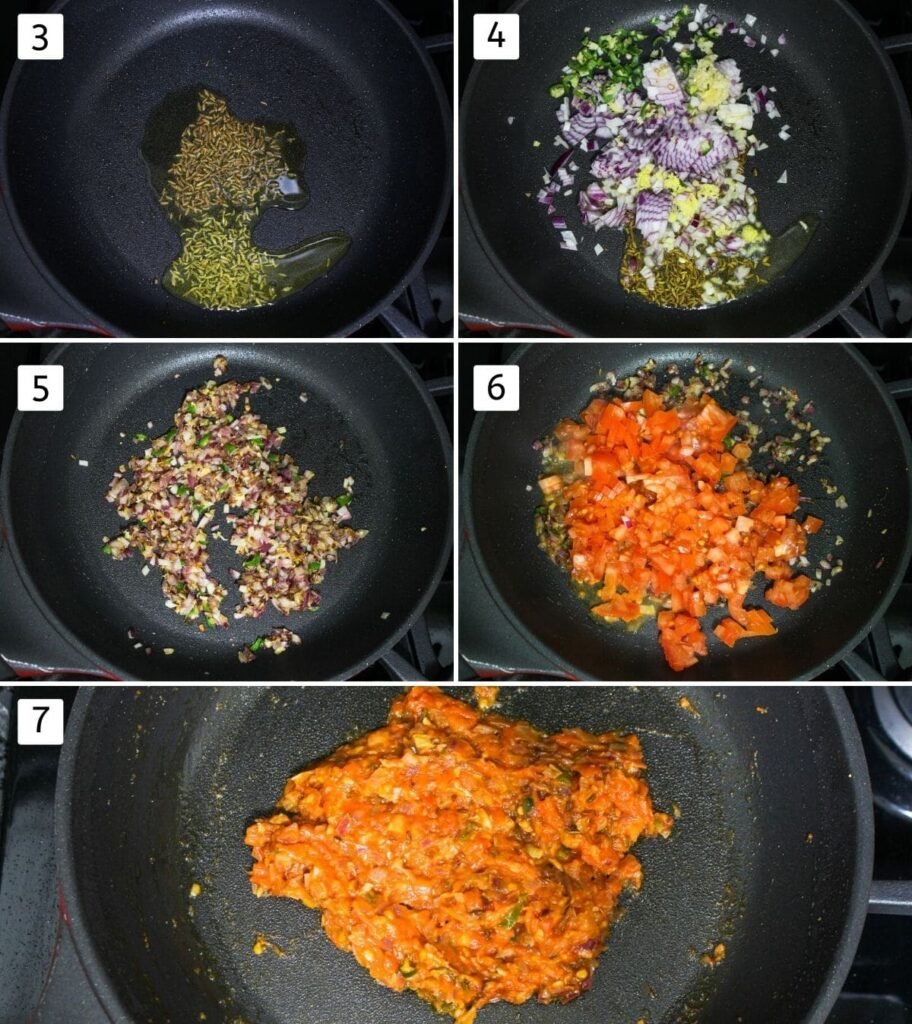
8) Next, add turmeric, red chili powder, coriander powder, and the rest of the salt, sprinkling them evenly over the masala. Stir well to coat everything evenly in the spices.
9) Let the spice mixture cook for around a minute, stirring occasionally, until the oil begins to release from the sides—this signals that the masala is well-roasted and aromatic.
10) Pour in some water (as needed for your preferred gravy consistency) and bring the mixture to a gentle boil. Lower the heat and allow the gravy to gently simmer for 4 to 5 minutes, giving the spices time to meld and develop a rich, well-rounded flavor.
11)Now comes the important part—slowly incorporate the yogurt, stirring continuously to ensure it blends smoothly without curdling. Keep the flame at its lowest. Slowly pour in the whisked yogurt with one hand, while continuously stirring the gravy with the other. This helps to prevent the yogurt from curdling.
12) Once the yogurt is fully blended and smooth, you can gently increase the heat back to medium.
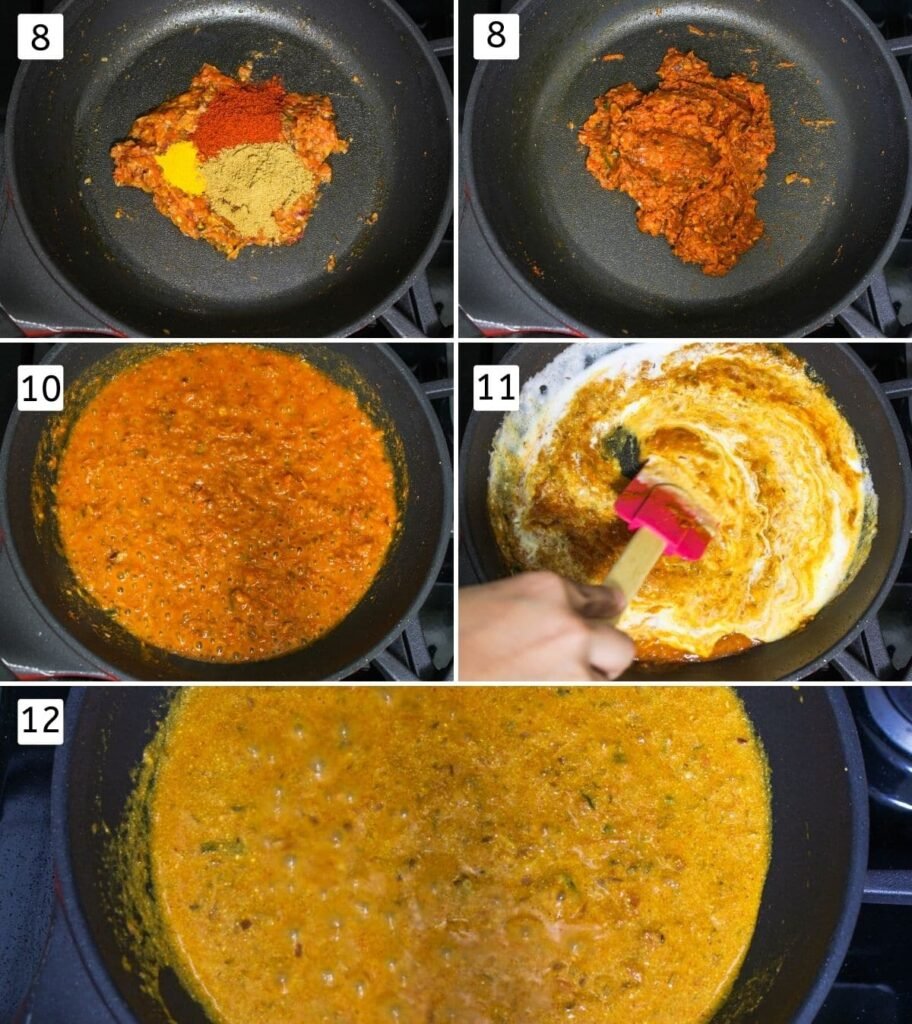
13) Next, sprinkle a pinch of garam masala and add crushed kasoori methi to the gravy. For maximum flavor, rub the dried fenugreek leaves between your palms before adding—this helps release their natural oils and aroma, giving the dish an irresistible earthy finish.
14) Gently add the sautéed okra back into the pan, stirring it into the flavorful yogurt-based gravy so that each piece is well coated. Mix gently so the bhindi gets coated with the creamy yogurt-based gravy.
15) Let it simmer gently for about 2 minutes. Be careful not to overcook, as the okra can turn overly soft and lose its texture. Turn off the heat and your Dahi Bhindi is ready to serve!
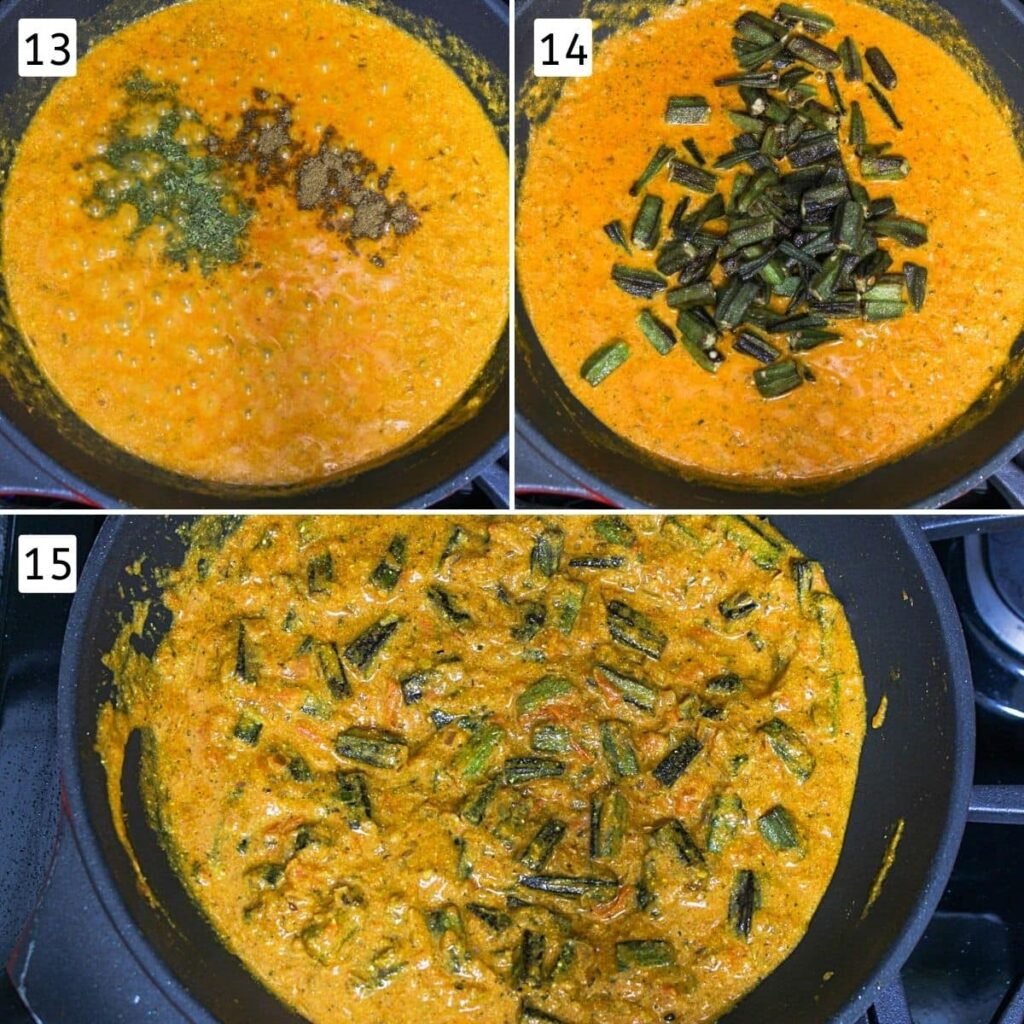
Expert Tips For Making Dahi Bhindi:
- Buying Okra: When selecting okra, always choose ones that are fresh, vibrant green, and firm to the touch. Avoid okra that looks dull, has blemishes, or shows signs of cuts or oozing. Thin, tender pods typically contain fewer seeds and cook better—these are often found in Indian grocery stores and are preferred for dishes like dahi bhindi.
- Tips to Avoid Sliminess: Okra tends to get slimy if not handled correctly. To reduce this, make sure the okra is completely dry before chopping. After washing, let it air-dry in a colander or pat it dry thoroughly using a clean kitchen towel or paper towel.
- While chopping, clean the knife frequently if it gets sticky. This small step really helps prevent buildup of the mucilage.
- When cooking, stir the okra only a couple of times—too much stirring will activate the slimy texture. Also, avoid covering the pan while sautéing; cooking uncovered allows the moisture to escape and keeps the okra crisp and non-sticky.
- Cooking Okra Perfectly: When cooking the bhindi, aim for a texture that is tender yet retains a slight bite. The pieces should remain whole and not fall apart. Overcooking can make them soft, mushy, and unappealing in the final dish.
- Adding Yogurt – Handle with Care: Yogurt can easily split if not added correctly. Always lower the heat to a minimum before incorporating the whisked yogurt into the curry. Stir continuously while adding it to maintain a smooth, creamy consistency. Curdled yogurt will spoil both the taste and appearance of the gravy.
- Final Simmering Tip: Once the cooked bhindi is mixed into the yogurt-based gravy, let it simmer for just a minute or two. Prolonged simmering will make the okra mushy and drain its flavor.
